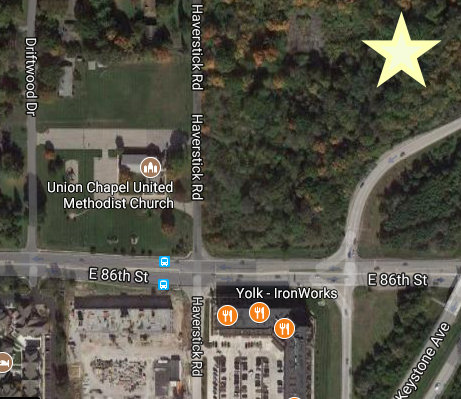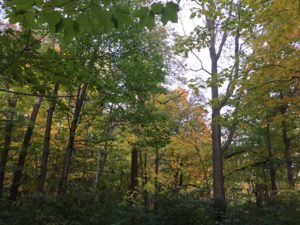By Clarke Kahlo
Haverstick Woods is the last forest stand in the busiest retail corridor in the city of Indianapolis. But a developer is lobbying the Metropolitan Development Commission to re-zone it for yet another office building with retail at street level. Here are 11 reasons why the Commission should reject this proposal as most residents already have. They’ve even formed a group called Northside Neighbors Against Alexander at the Crossing to speak out against the destruction of this forest.
 Join them, IFA Executive Director Jeff Stant, and our members at a Commission hearing Wednesday, October 4, the Indianapolis City-County Building, 200 E. Washington St., Room 230, from 1 to 3:30 p.m. It’s our last chance to send a big message to city planners: more development is not the answer for a better quality of life: more forest area. Here’s why we’re in favor of letting this forest stand:
Join them, IFA Executive Director Jeff Stant, and our members at a Commission hearing Wednesday, October 4, the Indianapolis City-County Building, 200 E. Washington St., Room 230, from 1 to 3:30 p.m. It’s our last chance to send a big message to city planners: more development is not the answer for a better quality of life: more forest area. Here’s why we’re in favor of letting this forest stand:
1. NO NEED FOR MORE RETAIL: The Haverstick Woods is a prime potential urban forest, in an area sorely in need of parks and natural areas, which does not need more commercial retail and office space. Indy ranked last among 100 cities for park investment and access.
2. GREAT NEED FOR NEW PARK: The Indianapolis Parks Department has indicated a strong interest in adding this site to its park system if a no-public-cost acquisition strategy can be implemented. (However, as per long-standing unofficial city policy, Indy Parks will not take a public position lest it conflict with the recommendations of other City agencies such as DMD and DPW, and any opinions of the Mayor’s office.
3. TRAFFIC GRIDLOCK WILL ONLY WORSEN: Traffic congestion in the Keystone at the Crossing and Nora area has become an all-too-frequent vexing condition for motorists. A park, instead of a retail, commercial building with a 360-space parking lot, would ease, or at least not substantially exacerbate, traffic congestion. The City has signed off on study-after-study showing no impact from proposed developments. yet the resultant real-world experience by motorists at the location–as well as all along the entirety of 86/82nd–is gridlock (Level of Service ratings F and D) many times throughout the day.
4. THE NORA COUNCIL IS AGAINST THIS DEVELOPMENT: After much consideration and many meetings, The Nora-Northside Community Council voted resoundingly (9 to 2) to take a position of Objection to the petition. The Driftwood Hills Neighborhood Association has also voted to oppose it.
5. LOWER QUALITY OF LIFE FOR RESIDENTS: A commercial use petition would constitute an attack upon the use and value of nearby neighborhoods because the tract is so situated that it would, if developed as proposed, exert negative community impact traffic congestion and hazards, emergency vehicle impairment, light pollution, the urban heat island effect, loss of buffer for noise pollution and particulate (air) pollution, and short-cut traffic from the primary arterials and onto narrow Haverstick Rd. and East 91st Street (which are neither planned nor constructed as arterial streets).
6. THE WOODS PROVIDE SERVICES SUCH AS RUNOFF ABSORPTION: The development will cause excessive stormwater discharges, and increased flooding in already flood-prone areas such as the River Park neighborhood to the south. Currently, the forest provides the excellent service of stormwater runoff absorption. The developer’s proposed storage tanks will likely not be large enough to capture half the runoff that the forest now does. Healthy, heavily treed riparian environments make society’s job of cleaning water much easier and cheaper once it hits the water treatment plant. If the woods are developed, much more dirty water will shoot straight into the White River.
7. IT WOULD CREATE A ZONING PRECEDENT: Approval of this commercial use would also create a zoning precedent which, thereafter, would encourage strip development and commercial sprawl to the west unless the regulatory authorities (zoning boards and commissions) are able to draw (and hold) the line. Unfortunately, as we increasingly learn, we cannot rely on history, applicable precedent, agency resolve, or accumulated wisdom in public policy-making. The public must vigorously defend against this dangerous proposal.
8. LEAVING THE WOODS WOULD HELP FULFILL THE MAYOR’S NEW SUSTAINABILITY AND RESILIENCE ACTION PLAN: A standing forest. There’s no cheaper way to mitigate climate change, since trees are the perfect instrument for absorbing carbon.
9. LEAVING THE WOODS SHOWS THAT INDIANAPOLIS “VALUES COMMUNITIES & NEIGHBORHOODS”: Last year, Indy Rezone, a major update of the City’s zoning ordinances, was introduced. It contained six Livability Principles, as guidelines for future development decisions, including this one: Value Communities & Neighborhoods: Enhance the unique characteristics of all communities by investing in healthy, safe, and walkable neighborhoods, rural, urban, or suburban. What better way to enact this principle than retaining Haverstick Woods as a park?
10. IT’S A CRITICAL AREA: The tract has been designated as a Critical Area by the Marion County Comprehensive Plan. Why? The north side of 86th Street is primarily residential in nature. The residential areas are under development pressure from commercial expansion. There is no significant barrier west of Keystone Avenue to stop the process of commercial encroachment on 86th Street. If commercial development were allowed on any of these parcels, several more parcels on 86th Street could be in line to convert to commercial development as well. It is critical to protect the existing residential nature of this portion of 86th Street from any commercial development. Source: Marion County Insight
11. IT’S AN ANIMAL HABITAT WITH TALL TREES THAT PEOPLE LOVE AS IS: The site is a remnant natural heritage site featuring steep slope terrain which supports hundreds of older-growth trees and harbors much wildlife habitat in a highly paved over the area. Most of the site has never been developed due to steep slopes and heavy woods. It’s a wonderful place for kids to play in nature and for people to walk their dogs. How do you place a dollar value on that?

